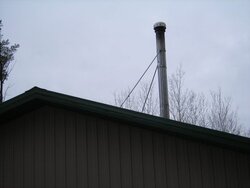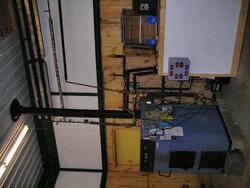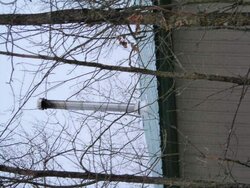OK guys.....
After the fiasco with my radiant floor system that I figured out this winter, I've decided to move the boiler into the shop, to utilize the waste heat from the boiler, tank, and plumbing to heat the shop..
Insurance company has given me the green light as long as the install is to code.
I'm using Selkirk SuperVent 8" chimney pipe from menards. Class A certified. I currently have 12 feet (4 sections) of pipe on the outside wall of the boiler shed. I have two ideas on the methods for installing on the shop. The shop is 40 feet wide. The eve height is 11.5 feet. The peak is somewhere in the 20 foot range. (Gonna have to get a ladder and helper to measure that.) I understand you need to have at least 3 feet of chimney higher than your peak. I am thinking that having 10 to 13 feet of chimney sticking up in mid air at the eve's is asking for disaster in the first storm that comes around.
Another option would be to move the boiler around so it sits inboard from the walls some, then run the chimney up through the roof. This would require penetrating a steel roof, which I'm not particularly fond of, but would support the chimney at probably the 14 foot level, leaving only three sections above the roof, which should be easily supported by a roof guy.....
What do you guys think?
-Matt
After the fiasco with my radiant floor system that I figured out this winter, I've decided to move the boiler into the shop, to utilize the waste heat from the boiler, tank, and plumbing to heat the shop..
Insurance company has given me the green light as long as the install is to code.
I'm using Selkirk SuperVent 8" chimney pipe from menards. Class A certified. I currently have 12 feet (4 sections) of pipe on the outside wall of the boiler shed. I have two ideas on the methods for installing on the shop. The shop is 40 feet wide. The eve height is 11.5 feet. The peak is somewhere in the 20 foot range. (Gonna have to get a ladder and helper to measure that.) I understand you need to have at least 3 feet of chimney higher than your peak. I am thinking that having 10 to 13 feet of chimney sticking up in mid air at the eve's is asking for disaster in the first storm that comes around.
Another option would be to move the boiler around so it sits inboard from the walls some, then run the chimney up through the roof. This would require penetrating a steel roof, which I'm not particularly fond of, but would support the chimney at probably the 14 foot level, leaving only three sections above the roof, which should be easily supported by a roof guy.....
What do you guys think?
-Matt






